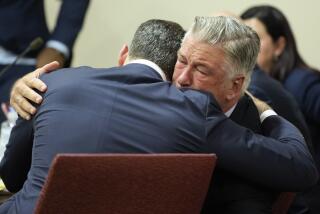Mistrial Is Declared in B.I.G. Trial
- Share via
A federal judge declared a mistrial in the Notorious B.I.G. wrongful-death suit Wednesday, ruling with attorneys for the rapper’s family who had accused Los Angeles police of intentionally withholding papers tying rogue officers to the rapper’s murder.
U.S. District Judge Florence-Marie Cooper informed lawyers for the city and for the family of Christopher Wallace, who was known as Notorious B.I.G., of her decision in a conference call Tuesday. Cooper’s court clerk said the judge would issue a written ruling today.
Family attorneys had accused police of deliberately concealing tapes and more than a thousand pages of internal Los Angeles Police Department documents, including transcripts of conversations with a jailhouse informant who placed two rogue officers, including the key figure in the Rampart police corruption scandal, at the scene of the 1997 Wallace shooting.
City lawyers said that any failure to turn over documents was unintentional and that Wallace family lawyers had overlooked some of the materials themselves. The documents and tapes contained only “second- and third-hand” allegations, they said.
Assistant City Atty. Don Vincent, however, said he was ready to try the case again.
“I’d like to see the case tried on its merits,” said Vincent. “And maybe now we’ll get to its merits.”
The ruling gives the Wallace family a chance to start over in a case that, from the start, raised serious concerns, including a lack of any direct evidence of police or city involvement.
Wallace attorney Perry Sanders said his first choice would have been for the judge to issue a default judgment in the family’s favor. But he said the mistrial would give his side more time to develop its theories.
“Now we are going to get to the bottom of everything,” Sanders said, “and we think this will strongly be tied to Rampart issues.”
Veteran civil rights attorney Stephen Yagman said a mistrial would benefit the city as much as the Wallace family.
“There has never been any downside risk for police and their lawyers engaging in misconduct in trial, but the consequence is that a mistrial will be declared and the trial will be done all over again,” Yagman said. Wallace, a 24-year-old Brooklyn-born rapper -- who also went by the name Biggie Smalls -- was gunned down in a car-to-car shooting March 9, 1997, after a party at the Petersen Automotive Museum in the Miracle Mile district. Wallace’s mother, Voletta, his sister and his widow, recording artist Faith Evans, sued the city three years ago, alleging wrongful death and civil rights violations.
Despite criminal investigations by the LAPD and the FBI, no one has been arrested and the case remains unsolved.
The lack of closure has fueled conspiracy theories, fanned by former LAPD Det. Russell Poole, who accused the LAPD of covering up corrupt police involvement in the shooting.
Poole said the murder stemmed from a violent feud between Los Angeles-based Death Row Records and New York’s Bad Boy Entertainment, the label representing Wallace, and was ordered as payback for the killing six months earlier of Death Row artist Tupac Shakur.
Central to the plaintiffs’ circumstantial case was an allegation that David A. Mack -- an ex-LAPD officer and convicted bank robber -- orchestrated the slaying with the help of college friend Amir Muhammad on behalf of Death Row Records chief Marion “Suge” Knight.
All three men have denied any role in the killing, and the family dropped Muhammad and Mack as defendants before the trial. When testimony began June 21, Wallace family lawyers told jurors they would prove their circumstantial case, weaving “a mosaic” that tied Mack to Death Row, the Mob Piru Bloods street gang in Compton, as well as former Officer Rafael Perez, the key figure in the Rampart police corruption scandal.
In all, nine witnesses testified over four days before the six-man, three-woman jury. None of the witnesses, including a Death Row security guard, conclusively linked Mack or Perez to the record label or put them at the murder scene.
Kevin Hackie, a former Death Row Records bodyguard and onetime FBI informant, recanted statements he made under oath that Mack had worked in a “covert capacity” for Death Row.
Wallace family attorneys told jurors that many of the witnesses probably feared for their lives.
But testimony came to a halt after four days when plaintiffs’ attorneys announced in court they had received an anonymous tip that an LAPD informant had tied Perez and Mack to the killing.
In an extraordinary move, LAPD Internal Affairs investigators locked down the department’s Robbery Homicide Division, seizing tapes and transcripts of conversations between the informant and two detectives.
City attorneys also were forced to produce hundreds of pages of other police personnel and disciplinary files that the plaintiffs had not received before trial.
One of the most significant documents was a transcript of the LAPD informant’s statements to police.
Transcripts of the informant, identified as Kenneth Boagni, were found in LAPD Det. Steven Katz’s desk in the Robbery Homicide Division. Boagni, who is serving 40 years to life in state prison, on Tuesday refused to be deposed by lawyers on either side of the case. Boagni said he feared his family would be hurt or he would be killed if he talked, family lawyers said.
The judge is expected to fax a written ruling to lawyers today, laying out the reasoning behind her mistrial order and any other sanctions she will impose on the city for the retrial.
More to Read
Sign up for Essential California
The most important California stories and recommendations in your inbox every morning.
You may occasionally receive promotional content from the Los Angeles Times.













